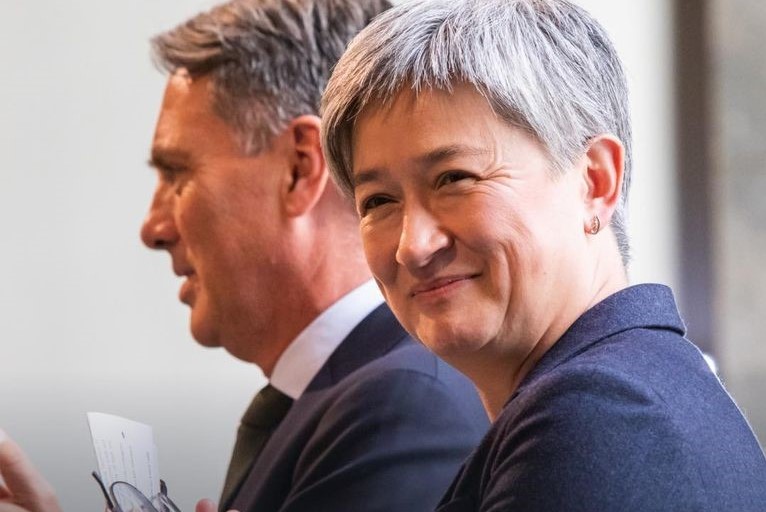
In a budget speech that focused on domestic priorities, Treasurer Jim Chalmers’s only international announcement was of a package allocating $1.9 billion to strengthening Australia’s relationships in the Pacific.
It wasn’t a surprise that the Pacific region was a focus of the budget. The priority placed on the region has been demonstrated by Minister for Foreign Affairs Penny Wong visiting every Pacific Islands Forum country during the government’s first 12 months in office.
What is notable, though, is the way the package is being delivered. It will involve 13 agencies across government, and most of it won’t be given as development assistance.
It’s clear that a whole-of-government approach is gaining traction when departments and agencies as diverse as Treasury, Services Australia and the Fair Work Ombudsman are all seen as able to contribute to enhancing engagement with Australia’s Pacific neighbours.
Some parts of the package focus on issues of internal security. For example, the Attorney-General’s Department will receive $12 million over four years to work with the Australian Federal Police to strengthen Pacific law enforcement and criminal justice cooperation.
The AFP’s international engagement is another big winner, with a substantial boost of $71.9 million per year over the next four years. And more than $30 million has been earmarked for the Department of Home Affairs.
But there’s also a strong economic focus on Pacific workers coming to Australia.
Funding of $370.8 million over four years has been committed to expand and improve the Pacific Australia Labour Mobility scheme, to support sustainable growth and improve support for workers in line with Australian and Pacific aspirations. Of this, the Department of Employment and Workplace Relations is set to receive almost $170 million over four years to maximise its economic contribution to supporting Pacific economies and addressing the workforce shortage in Australia.
People-to-people connections are also a focus of the package, with funding of $89.5 million over four years to deepen ties with the region and promote shared values. The Department of Infrastructure, Transport, Regional Development, Communications and the Arts will receive $5.8 million a year for the next four years to contribute to strengthening cultural and people-to-people ties with the region.
The ABC will receive $8.5 million over four years to expand the Indo-Pacific broadcasting strategy, boosting media connections and enabling more Pacific island peoples to access Australian content. Even the Department of Health and Ageing is receiving $3.5 million over the next four years to enhance Pacific sports diplomacy, bringing people closer through a shared love of sport. Overall, these measures are presented as leveraging Australia’s strengths in media and sport.
The largest element of the package is for defence cooperation, to be met from within existing resources. The Department of Defence will have to find $920 million in savings over four years to fund Pacific peace and security initiatives.
This will include expansion of defence engagement with Pacific island countries through the provision of infrastructure and maritime security capability. Media reports have focused on key Pacific wharves and the joint redevelopment of the Lombrum Naval Base in Papua New Guinea as infrastructure projects.
While official development assistance through the Department of Foreign Affairs and Trade comprises only $114 million of the package, that needs to be put in the context of the $900 million in new funding that was committed to the Pacific in the supplementary budget in October 2022. This month’s budget shows implementation of these commitments and where they will start to flow.
New DFAT funding is earmarked to support ‘a stronger, more united Pacific region’, including supporting the Pacific Islands Forum, strengthening humanitarian relief and disaster preparedness, and improving diplomatic capability and cyber resilience. Some of the increased funding is for bringing an Indigenous perspective to Pacific engagement in line with Australia’s First Nations foreign policy.
Looking at the whole package, it shows that the Australian government is thinking about engagement broadly—across multiple parts of government and through a range of tools. This is line with an increasing commitment to using all the elements of statecraft among Australian policymakers.
Interestingly, the details of the package were announced jointly by Wong, Deputy Prime Minister and Minister for Defence Richard Marles, Attorney-General Mark Dreyfus and Minister for International Development and the Pacific and Minister for Defence Industry Pat Conroy.
The ministers noted that the package is designed to ‘respond to Pacific priorities and ensure our shared interests in a peaceful, prosperous and resilient region’. In similar terms, the budget statement said it will ‘support Pacific family priorities and commitments under the 2050 Strategy for the Blue Pacific Continent’.
It can thus be seen as a direct response to the ministers’ listening tour to Pacific island states. This suggests that what the Pacific wants from Australia includes engagement from across Australian government and society in line with Pacific priorities for national development.
The challenge for Australia will be to implement this vision of whole-of-government engagement through effective coordination across the many government partners delivering the package.

